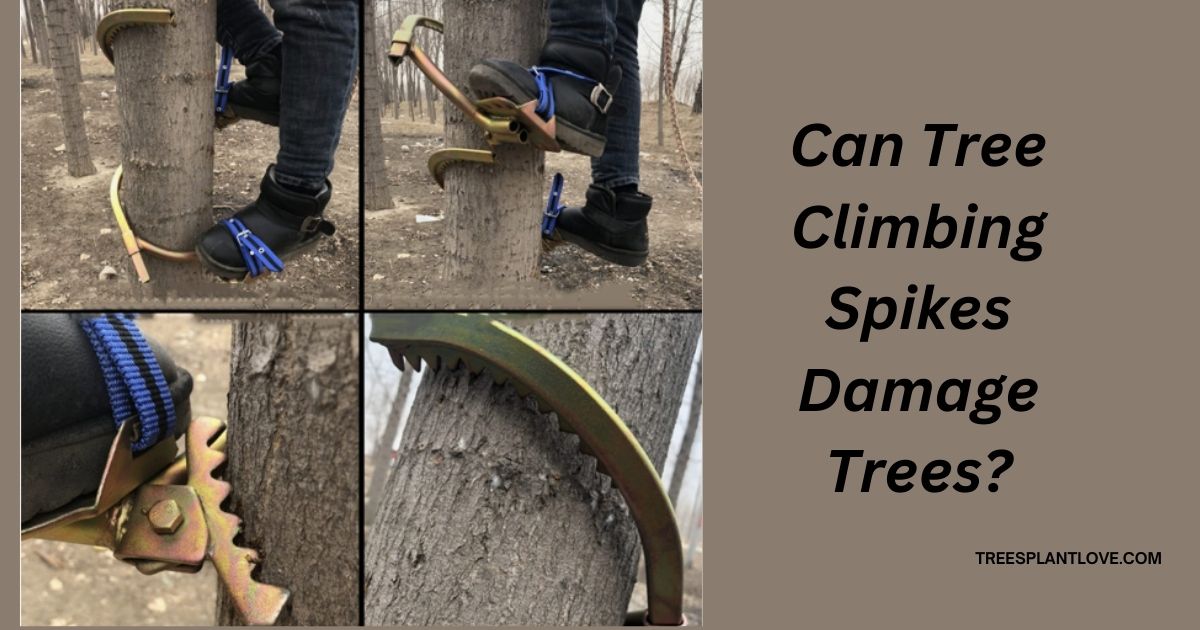
Can Tree Climbing Spikes Damage Trees? Understand the Risks and Best Practices
Can Tree Climbing Spikes Damage Trees?: Tree climbing is an essential skill for arborists, landscapers, and outdoor enthusiasts. Whether you’re trimming branches, pruning, or simply accessing the top of a tree, the right tools are crucial. One of the most common tools used in tree climbing is the tree climbing spike (or spur).
These specialized devices are worn on the climber’s legs and feature sharp metal points that dig into the bark to provide grip as the climber ascends. However, a common concern among tree care professionals and tree lovers alike is whether these spikes can damage the trees they’re used on. In this article, we will explore how tree climbing spikes work, the potential risks they pose to trees, and best practices for minimizing harm to the environment.
What Are Tree Climbing Spikes?
Tree climbing spikes are worn on the climber’s legs and consist of a metal point that sticks into the tree’s bark. They are often used by professional arborists and tree care workers to climb trees that are difficult to scale without assistance. The spikes allow the climber to grip the tree’s bark securely and ascend with greater ease.
Climbers typically use two types of spikes: tree climbing spurs, which are designed for long-term or sustained climbing, and pruning spikes, which are used specifically for trimming or removing tree limbs. The spike itself is mounted on a strap or harness that the climber fastens around their leg.
Can Tree Climbing Spikes Cause Damage?
While tree climbing spikes are incredibly effective for climbing trees, they can indeed cause harm to the tree if not used correctly or with proper care. The sharp metal points dig into the tree’s bark and, in some cases, penetrate the living tissue underneath. This can cause several types of damage:
- Physical Damage to the Bark The primary way that spikes can harm a tree is by puncturing or tearing the bark. The bark serves as the tree’s protective outer layer, shielding it from pests, diseases, and environmental stressors. When tree climbing spikes puncture or rip through the bark, they leave open wounds. These wounds can become entry points for bacteria, fungi, and insects, which can lead to infection or disease. Over time, repeated use of spikes can weaken the tree’s defense systems and even cause the bark to die.
- Damage to the Vascular System Beneath the bark lies the cambium layer, which is responsible for transporting nutrients and water throughout the tree. If climbing spikes penetrate this layer, they can disrupt the tree’s vascular system. The result may be a decrease in the tree’s ability to transport nutrients, potentially causing dieback in the branches or sections of the tree. In some cases, spikes that penetrate deep enough into the cambium can cause permanent damage or even kill parts of the tree.
- Stress and Scarring Climbing spikes can also create long-lasting scarring on the trunk or branches. Even if the tree isn’t immediately harmed, the scars left behind can be areas of weakness that may affect the tree’s overall health. In addition, the repeated pressure from spikes in the same spot can cause chronic stress on the tree, potentially leading to stunted growth or poor overall health.
- Exposing the Tree to Infection When spikes damage the tree’s bark, they can expose the inner layers to infections. Pathogens, including fungi and bacteria, can infiltrate these open wounds and spread throughout the tree. This is especially a risk in high-humidity areas or places with a high volume of insect activity. A compromised immune system makes the tree more susceptible to diseases such as root rot, fungal infections, and blights.
How to Minimize Tree Damage When Using Climbing Spikes
While tree climbing spikescan be harmful, they are sometimes necessary for specific tasks. However, there are strategies that climbers can implement to minimize the risk of damage to trees:
- Use Spikes Only When Absolutely Necessary Ideally, tree climbing spikes should be used only when climbing a tree is not possible with other methods. For example, when climbing a tree for pruning or maintenance, consider using a rope or other climbing equipment like ascenders and harnesses that do not harm the bark. Spikes should be reserved for specific tasks like removing dead trees or for climbing extremely large trees with thick bark.
- Limit Climbing Time If spikes must be used, it’s important to limit the amount of time spent climbing the tree. Prolonged use increases the likelihood of damage to the bark, cambium, and vascular system. Try to complete the task efficiently and avoid unnecessary pressure on the tree.
- Use Spike Pads or Protective Gear Some arborists use padded straps or other protective gear to minimize the pressure spikes put on the tree’s bark. These pads are designed to distribute the weight of the climber over a larger surface area, reducing the risk of concentrated damage at the points of contact.
- Inspect the Tree Before Climbing Before using climbing spikes, inspect the tree for any signs of disease or weakened bark. If the tree has soft or rotting bark, avoid using climbing spikes, as the damage will be more severe. A healthy, sturdy tree with robust bark will be better equipped to handle the pressure from the spikes.
- Minimize Entry Points Climbers should aim to use the same climbing spots to reduce the number of entry points created by the spikes. Creating too many punctures in the bark can lead to compounding damage, so try to focus on a few key locations that can be carefully managed.
Conclusion
In conclusion, tree climbing spikes are an essential tool for climbing trees, but they do come with the potential for significant harm to the tree. The damage caused by tree climbing spikes can range from physical harm to the bark to deeper injury of the vascular system, and long-term use can result in the tree’s weakening. As a result, it’s crucial for climbers to carefully consider when and how they use climbing spikes to minimize damage.
By following best practices and using climbing spikes sparingly, arborists and climbers can safely complete their work while helping protect the long-term health and vitality of the trees they climb. If you’re unsure whether tree climbing spikes are the right choice for your task, consulting with an experienced arborist can help guide your decision-making.

Leave a Reply